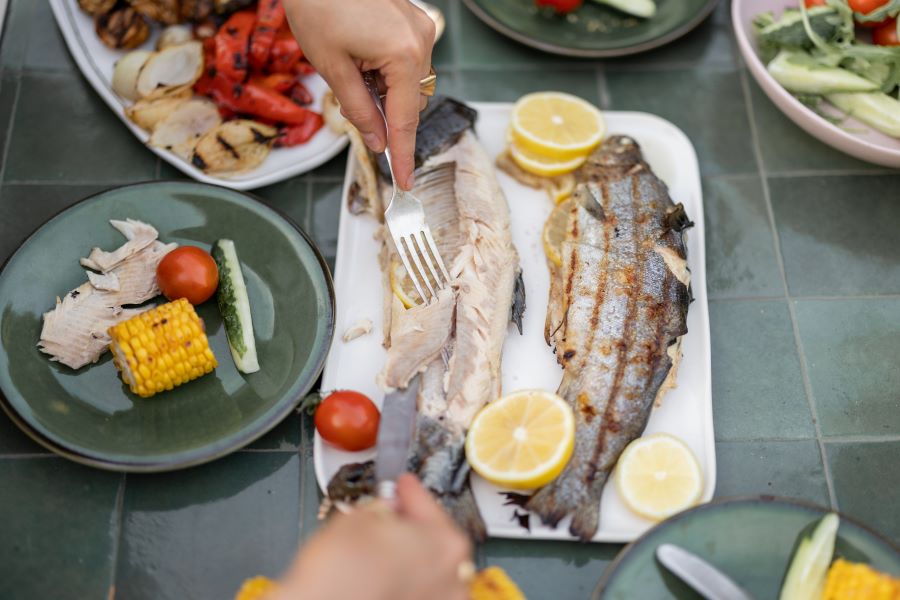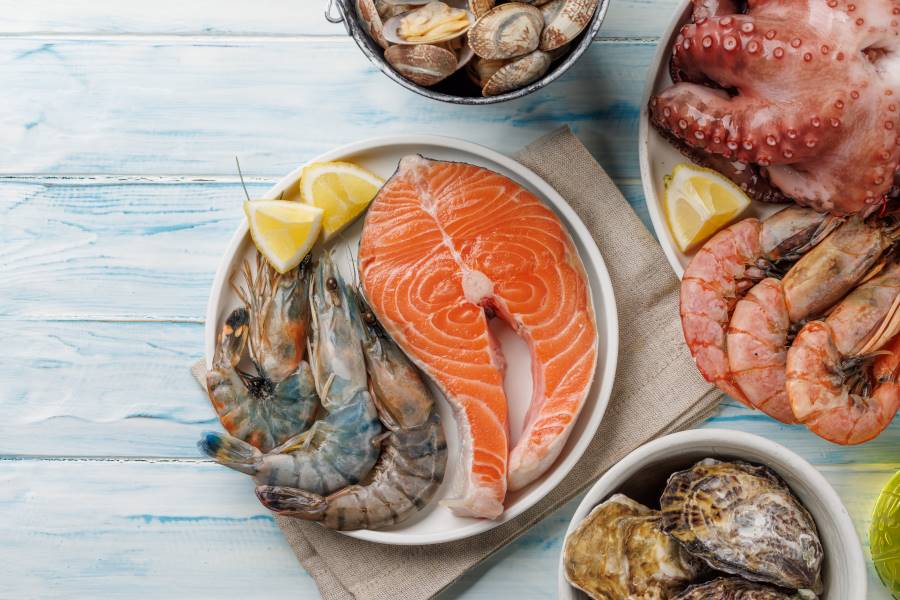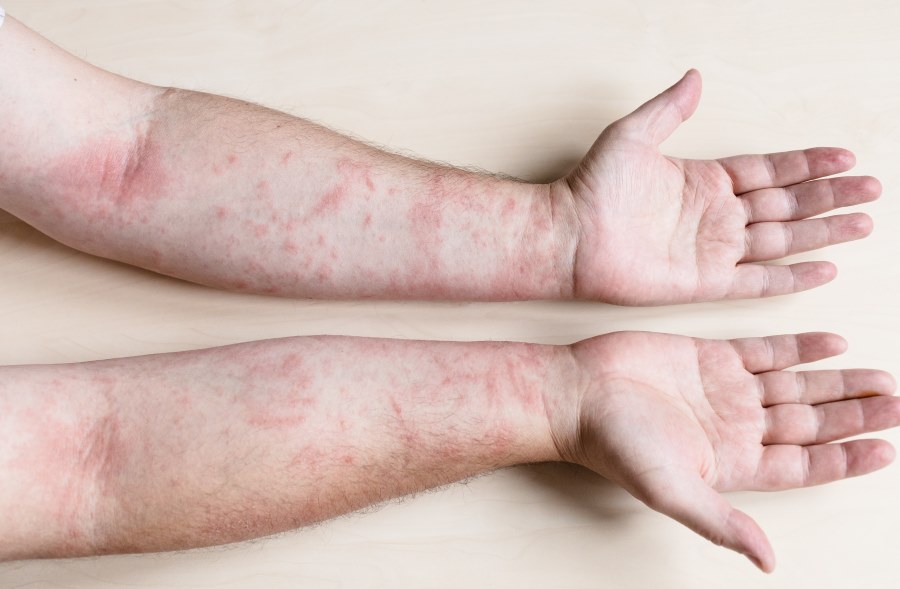How to Treat & Cure Seafoo Allergy at Home?

Seafood allergy occurs to an individual whose body's immunity system responds to the proteins found in specific marine animals. Seafood comprises shellfish, such as shrimps, mussels, octopus, lobster, crab, squid, clams, and finned fish, such as mackerel, tuna, salmon, cod, and sardines.
Are you suffering from an allergy to any of these seafood? If yes, dedicate your next few minutes to reading this article, as it summarises the vital aspects of seafood allergies.

Table of Contents

What is a Seafood Allergy?
Seafood allergy is defined as hypersensitivity to some specific proteins found in seafood, including both fish and shellfish. It occurs when already allergic persons consume seafood since their immune system perceives the proteins contained in such seafood dishes as hazards and begins to react.
Such symptoms in food-allergic individuals are apologetic hives and pruritus to debilitating swelling, abdominal cramps, vomiting, or rabid anaphylaxis. Likewise, it is necessary to avoid the food mentioned above and take care of ingredients when necessary to control this allergy effectively.
Types of Seafood Allergy

Types of seafood allergy can also be classified depending on the single affecting proteins that cause allergic hypersensitivity. Here are the predominant types:
What Causes Seafood Allergy?
In every allergy, the immunity system of your body responds to allergens. Your body generates antibodies to identify the allergens, causes inflammation, and produces a chemical known as histamine, which causes allergic symptoms such as hives. In addition, there are specific molecules in fish or shellfish that may be available in other foods, and you may suffer from allergies from those foods containing that molecule.
For example, you may suffer from an allergy to a specific fish or may be allergic to multiple crustaceans such as prawns, lobster, and crab. This is called cross-reactivity and is difficult to diagnose.
Other things, such as being allergic to algae or shellfish, which are well-known reasons for allergies to seafood, also belong to this category. Sometimes, even keeping the seafood away from the patient’s vicinity while preparing the meal can work. There are also such instances when there is crab or prawn-associated allergic reaction in patients, which is discovered later in life. Therefore, consult a doctor if you suffer from such a condition.
What are the Main Symptoms of Seafood Allergies?

Seafood comprises both shellfish and finned fish; however, they differ biologically. Therefore, if you suffer from an allergy to finned fish, that does not imply that you may be allergic to shellfish. Moreover, the crustaceans within the shellfish group, such as prawn, crab, crayfish, lobster, etc., cause more allergies than mollusks, including octopus, oysters, snails, etc.
However, whether you suffer from shellfish allergy or you are allergic to fish, identify the following symptoms, which are common for both these allergies, and report to a doctor immediately:
The symptoms mentioned above may differ with each seafood. For example, crab allergy and prawn allergy symptoms include itching or tingling sensation in and around the mouth. Additionally, symptoms may vary with each individual.
Allergies to fish or shellfish may cause anaphylaxis in rare cases. This severe medical condition demands immediate medical attention.
If you are suffering from severe prawn allergy or is allergic to any other seafood, look for the following symptoms of anaphylaxis to remain aware beforehand:
These are the common symptoms that you may find in the symptoms of shrimp allergy or allergies to other seafood. However, this may worsen. So, contact your nearest clinic if you or your close ones meet such a severe medical condition to avoid fatal consequences.
What are the Diagnosis and Treatment for Seafood Allergy?
Allergies to seafood, including fish and shellfish, may last for an entire lifespan. If you suffer from allergic symptoms from seafood, contact a doctor. He or she may refer you to a clinical immunologist or an allergist.
An allergist may perform the following test depending upon the type of allergies:
- Blood test
- Skin prick test
- He or she may also advise to stop consuming seafood temporarily
- Patch test (to determine delayed allergic reactions)
- Specific IgE testing (to identify specific seafood allergens)
If you have an allergy to a particular fish type and are willing to consume other types of seafood available in the market, you may ask the specialist to perform allergic tests for other kinds of fish.
If you suffer from severe symptoms of crab allergy or exhibit other allergic symptoms to seafood, the doctor may prescribe you an antihistamine. This reduces swelling, hives, and other skin rashes, if any. However, if you meet a severe condition like anaphylaxis, you may be treated with epinephrine.
If you are at risk of developing anaphylaxis, a healthcare professional may prescribe you to keep injectable epinephrine always with you. In addition, he or she may recommend you to administer epinephrine even if your body displays symptoms of seafood allergy for the first time as a precautionary measure
Affordable Health Insurance Options for You and Your Family
How to Prevent Seafood Allergy?

Go through the following preventive measures to prevent seafood allergy:
1. Avoid Consuming Seafood
Take a look at the list of fishes that may trigger your allergic symptoms caused by fishes:
- Cod
- Barramundi
- Salmon
- Snapper
- Whiting
- Flake
- Tuna
- Trout
Here is the list of shellfish that you must avoid that may aggravate your allergic reaction to prawns or other shellfish:
- Crayfish
- Mussels
- Cuttlefish
- Calamari
- Oysters
- Lobster
- Squid
- Prawns
2. Be Aware While Eating Outside
When eating at a restaurant, check that the utensils utilised for cooking seafood are not used for cooking other food dishes. This is why it is ideal to avoid dining out at a restaurant that specialises in seafood. Additionally, avoid sharing plates with those consuming seafood to prevent cross-contamination.
Additionally, avoid visiting places where the seafood is processed or prepared. Inhaling the vapour from the cooked seafood may cause a respiratory reaction among selected individuals with seafood or shellfish allergy symptoms.
3. Add Right Foods to Your Diet
Home remedies for prawn allergy or other shellfish allergies may naturally calm down the allergic symptoms. Adding foods like yoghurt, vitamin C-rich foods such as oranges and broccoli, foods and drinks like ginger and green tea to your diet may help with seafood allergies. However, in severe allergic reactions, contact a doctor without any delay.
Insufficient knowledge about seafood allergies may cause panic. Hence, carefully go through the information mentioned above if you suffer from a seafood allergy. Alternatively, consult a doctor to know more details about it.
4. Check Ingredient Labels
It is recommended to check ingredient labels for the presence of seafood or shellfish in frozen, canned, or any other processed food. Certain products have seafood or other seafood-derived additives that may not be listed as ingredients.
5. Communicate Your Allergy
Make sure to tell your friends, family, and hosts about the seafood allergy so they will understand the risk of preparing and serving suspicious foods. Communication is key in preventing accidental contact.
6. Carry an Epinephrine Auto-Injector
Those with a severe seafood allergy should have an epinephrine auto-injector (EpiPen) at all times. If ever exposed mistakenly or due to a severe allergy, this device can be relied on to provide relief until medical assistance arrives.
7. Educate Yourself on Cross-Contamination
Understand possible sources of cross-contamination, such as using the same equipment or working on the same surface, and try to eliminate them. Pay special attention to food prepared or served in the same location as seafood.
How to Treat Seafood Allergies at Home?
Seafood allergies can cause uncomfortable and sometimes dangerous reactions. Managing symptoms at home involves remedies to soothe mild reactions, but avoiding the allergens is essential. Below are home treatments for prawn, crab, shrimp, and general seafood allergies, along with recommended foods that can help.
1. Prawn Allergy Treatment at Home
For prawn allergies, antihistamines can alleviate mild symptoms like itching or hives. Cold compresses on affected skin areas can also reduce swelling. Drinking ginger tea may soothe nausea and other digestive issues.
Helpful foods: Ginger, turmeric, and green tea for their anti-inflammatory properties.
2. Crab Allergy Treatment at Home
Crab allergy symptoms can be managed with over-the-counter antihistamines to reduce rashes or skin irritation. Drink plenty of water to flush allergens from the system.
Helpful foods: Aloe vera, chamomile tea, and apples for their cooling and soothing effects.
3. Shrimp Allergy Treatment at Home
For shrimp allergies, avoid seafood and take antihistamines to control itching and swelling. Oatmeal baths can soothe skin irritations, and steam inhalation may help clear mild respiratory symptoms.
Helpful foods: Oats, garlic, and fennel for detoxification and soothing benefits.
4. Other Seafood Allergy Treatment at Home
Managing general seafood allergies includes staying hydrated and using antihistamines for relief. Applying natural remedies like honey can calm throat irritation. Keep environments allergen-free to avoid exposure.
Helpful foods: Honey, coconut water, and cucumbers for hydration and soothing effects.
Protect What Matters - Explore Other Insurance Options














